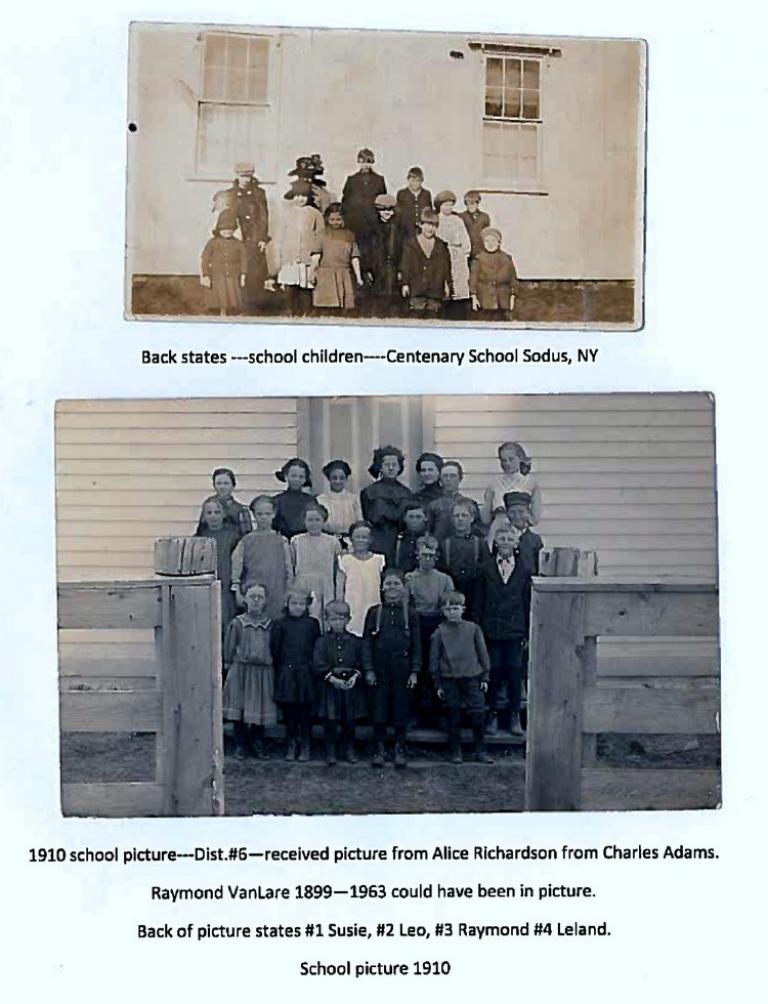The One-Room School
I recall the overpowering smell of chalk when I first entered our one-room schoolhouse in 1903. There may have been a combination of odors but to me it was chalk. Does chalk still smell?
Our school was District No. 6, Town of Sodus, Wayne Co., N .Y. and was on the northwest comer of Middle and Centenary roads. Twenty-five feet west was the Centenary church and church sheds.
Inside the school there were five double seats on each side and three triple seats in the center. In front of them was the stove. At the right of the door was the blackboard made of two wide boards in a frame and painted dull black. In front of it was the teacher’s chair and small table with the bell on it. A picture of a man’s head was on the wall. Later I learned it was William McKinley and the words underneath were “Not my will but Thine be done.”
Changes came. Soon we got slate blackboards, single shiny yellow desks with seats that went up and down and replaced the all-wood carpenter-made ones. It seemed we had the perfect equipment but it has been changing ever since. Now, 90 years later, I wonder if someone with a degree in child development will insist that we must have double seats so the beginners will not feel so alone, or suggest that several classes in the same room give the older ones a free review and the younger ones a challenge as they hear the advanced class. Or they may] suggest that closer contact will give them a better understanding ol’ other likes and dislikes and possibly twenty years later reduce the divorce rate by fifty percent. One never knows.
Ninety years ago, teachers qualified by completing four years of academy or high school and convincing the Commissioner of their moral character and devotion. Starting at seventeen or so, most did very well. The duties were simple; get there early, start the fire if needed, ring the bell., get the names and grades of each pupil, assign them to their seats, make out a schedule tor 8 grades if needed, supervise them during the noon hour. hear classes and sweep he floor after school. She also helped with leggings and fascinators, removed slivers and wiped tears and noses as needed.
Any, any, over [Annie, Annie, Over], tag, hide and seek, baseball, duck on the rock, and fox and geese in the winter were important. How did others get along in a bare yard with no church to run around or sheds to climb in or on‘? We boys learned to chew up good paper wads and throw them or better yet sit on the end of a ruler, put a soft one on the projecting end, push down and let it snap. Properly done, they hit the ceiling and stayed there. The teachers always objected. At least one year we had sitting up exercises in the morning.
Christmas and Valentine’s Day were properly observed. On Arbor Day, we went to a woods that was always white with trilliums. We also planted trees three or four times. They all died. The usual “his-and-hers” and woodshed were by the back fence. For good behavior, we were allowed to take six or seven erasers outdoors, beat them together or against the building to get rid of the chalk dust. Another reward was for two of us to go to a neighbor’s [home] for a pail of water. Later we were asked to get our own cup. My telescoping aluminum one didn’t last long. As we got older, we sometimes volunteered to stay after school and sweep the floor for the teachers.
Unless an important project was on our mind, noon was a time for socializing. The first move was to see what each had in their dinner pail. The contents were evaluated and some swapped whole sandwiches, others just a bite. When Earl brought woodchuck we were enthusiastic. My cousin Mark had some doubts and at home a few days later posed the question, “Does anyone ever eat woodchuck?” Uncle Nelson answered, “l should think not.” Pause. “Do you suppose it would kill them if they did?” Answer: “I should think it ought to.” Pause. “Earl’s folks do; he brought some to school one day last week.” “Did you eat any of it?” Pause. “Yes.” “Was that the day you were sick?” Pause. “Yes.”
Many of the girls taught only two or three years, so it seems appropriate: to say that the young teachers and the young children learned many important lessons in the one-room schoolhouse.

